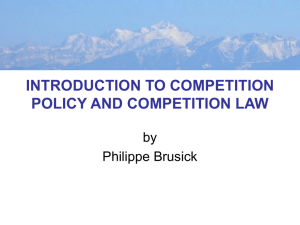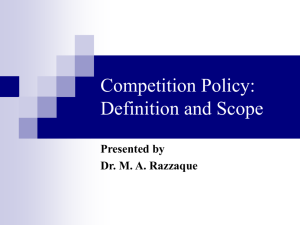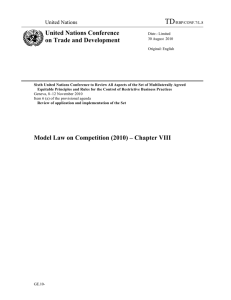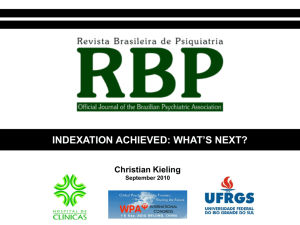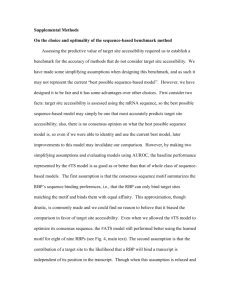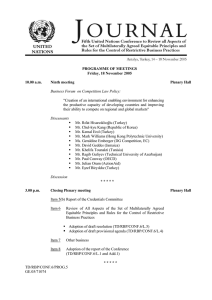TD United Nations Conference on Trade and
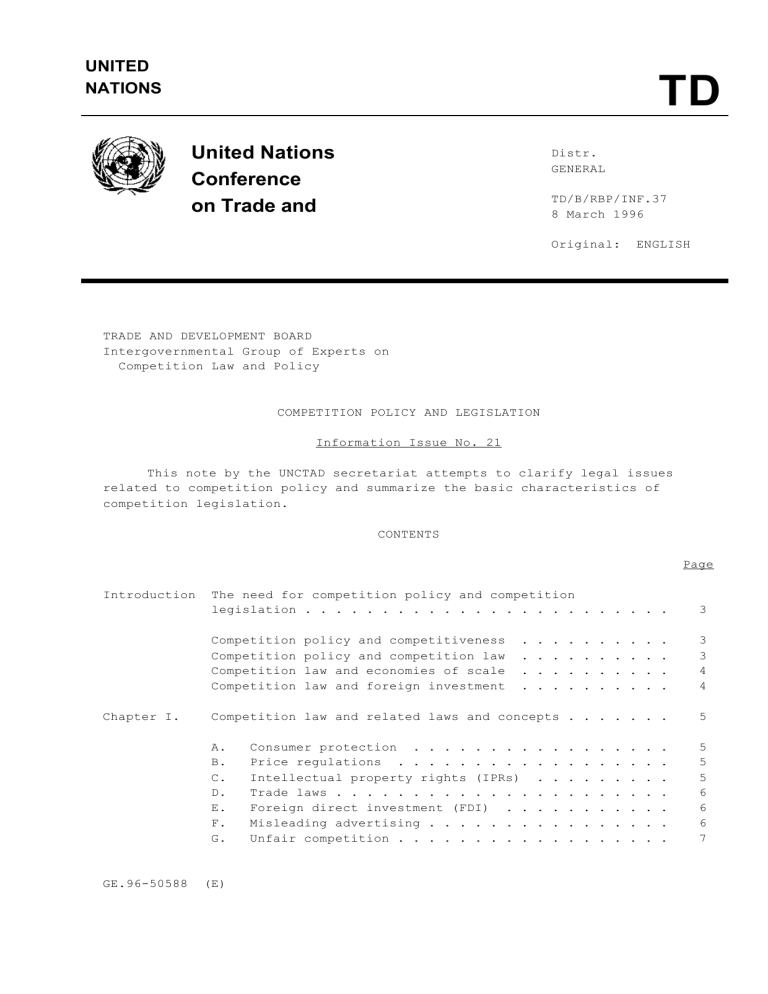
UNITED
NATIONS
United Nations
Conference on Trade and
TD
Distr.
GENERAL
TD/B/RBP/INF.37
8 March 1996
Original: ENGLISH
TRADE AND DEVELOPMENT BOARD
Intergovernmental Group of Experts on
Competition Law and Policy
COMPETITION POLICY AND LEGISLATION
Information Issue No. 21
This note by the UNCTAD secretariat attempts to clarify legal issues related to competition policy and summarize the basic characteristics of competition legislation.
CONTENTS
Page
Introduction The need for competition policy and competition legislation . . . . . . . . . . . . . . . . . . . . . . . .
Competition policy and competitiveness . . . . . . . . . .
Competition policy and competition law . . . . . . . . . .
Competition law and economies of scale . . . . . . . . . .
Competition law and foreign investment . . . . . . . . . .
Chapter I.
Competition law and related laws and concepts . . . . . . .
A.
B.
C.
D.
E.
F.
G.
Consumer protection
Price regulations
. . . . . . . . . . . . . . . . .
. . . . . . . . . . . . . . . . . .
Intellectual property rights (IPRs) . . . . . . . . .
Trade laws . . . . . . . . . . . . . . . . . . . . . .
Foreign direct investment (FDI) . . . . . . . . . . .
Misleading advertising . . . . . . . . . . . . . . . .
Unfair competition . . . . . . . . . . . . . . . . . .
5
5
6
5
5
6
6
7
3
3
3
4
4
GE.96-50588 (E)
TD/B/RBP/INF.37
page 2
CONTENTS (continued)
Chapter II.
Different approaches to competition legislation . . . . . .
Page
10
A.
B.
C.
Existing laws and laws in preparation . . . . . . . .
Structural versus behavioural control . . . . . . . .
Terminology and structure of basic competition law . .
(i) Objectives . . . . . . . . . . . . . . . . . .
(ii) Definitions . . . . . . . . . . . . . . . . . .
(iii) Scope of application . . . . . . . . . . . . .
(iv) Exemptions and exceptions . . . . . . . . . . .
10
11
11
12
13
14
14
D.
E.
F.
G.
H.
I.
J.
K.
Prohibited practices: horizontal and vertical practices . . . . . . . . . . . . . . . . . . . . . .
Merger control . . . . . . . . . . . . . . . . . . . .
Consumer protection . . . . . . . . . . . . . . . . .
The Competition Authority . . . . . . . . . . . . . .
Sanctions . . . . . . . . . . . . . . . . . . . . . .
Damages . . . . . . . . . . . . . . . . . . . . . . .
Class actions . . . . . . . . . . . . . . . . . . . .
Appeal procedures . . . . . . . . . . . . . . . . . .
16
17
17
18
18
18
19
19
Chapter III.
Basic procedures of investigating RBPs or mergers . . . . .
20
A.
Initiating an investigation . . . . . . . . . . . . .
20
(i) Sources of information . . . . . . . . . . . .
(ii) Preliminary assessment of the case . . . . . .
(iii) Analysis of the market . . . . . . . . . . . .
20
20
20
B.
The search for evidence . . . . . . . . . . . . . . .
22
(i) Search of premises . . . . . . . . . . . . . .
(ii) Questionnaires to firms . . . . . . . . . . . .
(iii) Announcements in newspapers . . . . . . . . . .
(iv) Hearings . . . . . . . . . . . . . . . . . . .
(v) Interim measures . . . . . . . . . . . . . . .
22
23
23
23
23
C.
Decisions and remedies . . . . . . . . . . . . . . . .
23
TD/B/RBP/INF.37
page 3
Introduction
THE NEED FOR COMPETITION POLICY AND COMPETITION LEGISLATION
Competition policy and competitiveness
1.
Competition policy has a wider connotation than competition legislation, the latter being a means to the end of competition policy. Another difference of terminology relates to competition versus competitiveness. It is sometimes argued that competitive economies do not need competition policy or competition legislation. In countries undertaking market-oriented reforms, for example, it was initially believed that opening the domestic market to import competition would be sufficient to create competitive markets without distortion. Some countries with highly successful sectors geared to compete in international markets have not felt the need to adopt competition legislation to ensure competitiveness on international markets; instead, they have dealt with particular anti-competitive practices by regulating specific sectors and certain activities such as government procurement (to avoid collusive tendering). However, under the pressure of market liberalization and globalization, it is generally admitted by a rapidly growing number of countries that competition policy, and hence competition legislation, is an essential element of the competitiveness of nations. This is also widely recognized in the United Nations Set of Principles and Rules for the Control of Restrictive Business Practices, 1/ adopted in 1980 by the United Nations
General Assembly.
Competition policy and competition law
2.
It has also been argued that, given the cost of introducing competition control mechanisms (legislation and Competition Authority), as well as the difficulties in implementing such complex concepts correctly, it may be preferable to avoid controls altogether and to let market forces, in the long run, resolve temporary restraints to competition. Moreover, sceptics of competition policy in developed countries have also argued at times that such complex concepts are even more hazardous if introduced in developing countries or in least developed countries. It should be noted, however, that competition policy without effective competition law is like an automobile without an engine. Even if implementation is gradual in the first years of application of a competition law, there is an essential learning process that needs some time to develop. For many developing countries and former centrally planned economies, the concepts of competition are very new. There is need for time and training to change mentalities and to create a "culture of competition". The first steps of newly established competition authorities, therefore, are often essentially educational with respect to business and consumer behaviour.
3.
Moreover, the legislative process itself is an evolutionary one. Even developed countries have amended and improved their competition laws periodically. Developing countries need to go through a similar "learning
TD/B/RBP/INF.37
page 4 process". But if market-oriented economic reforms are to be given a chance to succeed, there is need for competition policy, and such a policy needs competition legislation and a competition authority to monitor its application.
Competition law and economies of scale
4.
Market size and economies of scale might require the existence of a single firm in a given situation. However, with respect to tradable goods and services, market liberalization and technological change might remove the justification for the existence of most monopolies, or cause the "relevant market" to switch from the domestic market to the world market, hence transforming a national monopoly into a single national supplier in the world market, with the monopoly situation having disappeared as a result of trade liberalization.
Competition law and foreign investment
5.
It is also sometimes argued that competition legislation might deter foreign investment. However, serious implementation of competition policies and effective competition legislation applied in a fair and non-discriminatory manner will, on the contrary, reassure foreign firms that they will be treated in the same way as in their home market and that they will not face restrictive business practices from local competitors, private or public.
6.
A number of arguments often put forward against the adoption of competition legislation are listed in annex 1 to this note. Annex 2 sets out some of the difficulties and limitations often encountered by competition authorities once they have been established. Irrespective of such arguments and difficulties, the present information note aims at clarifying legal issues related to competition policy with a view to convincing the reader of the need for all countries to adopt competition legislation in implementation of a competition policy. While chapter I aims at clarifying the links of competition law with various other laws and concepts, such as foreign direct investment, unfair trade, intellectual property rules, consumer protection, etc., chapter II sets out in detail the basic structure and contents of any competition law, and chapter III describes in as pragmatic a manner as possible basic procedures for investigating restrictive business practices or controlling mergers.
TD/B/RBP/INF.37
page 5
Chapter I
COMPETITION LAW AND RELATED LAWS AND CONCEPTS
7.
Competition legislation is related in one way or another to a number of other laws and concepts, such as trade laws, FDI rules and intellectual property rules. Consumer protection rules, unfair competition, unfair trading and misleading advertising laws and price regulations may also have goals or provisions in common with or similar to those of competition law. However, a great deal of confusion can develop as a result of vague knowledge of often confusing terminology. Countries having no specific competition law might to a certain extent try to rely on such related bodies of law which cover some aspects of competition law but at the same time have fundamental differences.
A. Consumer protection
8.
Many developing countries adopt consumer protection legislation before, or at the same time as, competition legislation. As their name indicates, the objective of such laws is to protect the safety, health and economic interest of consumers, while competition law is directly aimed at promoting competition and efficiency in the economy and only indirectly defends the economic interests of consumers. As can be seen in chart I, however, competition law sometimes includes specific consumer protection provisions, such as prohibition of unfair trade practices (India) and obligation in respect of price labelling (France).
B. Price regulations
9.
Some national laws contain provisions related to RBPs and price regulation. As a result of economic reforms and price liberalization, many countries have gradually eliminated administrative regulation of prices and replaced this system by modern competition law (e.g. Norway, Sweden, France,
Thailand), though some competition laws still provide the possibility of enforcing price regulations in case of emergency (e.g. France). Moreover, all competition laws prohibit the practices of resale price maintenance (RPM) or price-fixing.
C. Intellectual property rights (IPRs)
10.
IPRs, including patents, copyrights, industrial designs and trade marks, in fact provide a monopoly to the owner (inventor or buyer) of an IPR. At first sight, such laws appear to be in direct contradiction with competition laws, which combat monopolies. However, deeper analysis comes to the conclusion that lack of IPRs would discourage investments in R & D and reduce innovation, which is one of the main benefits deriving from competition.
Hence the need for IPRs, which in effect are deemed to be pro-competitive overall, since firms that can enjoy such protection will be encouraged to compete by investing in R & D. Restraints, including major RBPs, can, however, be imposed through the licensing procedure of an IPR. Trade marks
TD/B/RBP/INF.37
page 6 can be used to seal off and monopolize specific markets. Views differ as to where the borderline lies between intellectual property rights which are pro-competitive and rights which are abusive and anti-competitive. Views on this borderline between competition law and IPRs need to be studied further.
D. Trade laws
11.
Trade laws in general are closely related to competition laws, since they have important effects on competition. In principle, dumping, which is the equivalent in international trade of predatory pricing, can justifiably be banned as being anti-competitive. However, anti-dumping rules might, in their application, have important anti-competitive side-effects. For example, anti-dumping action in some cases might close local markets to outside competition and reinforce local dominance by a few firms or by a cartel.
Subsidies may distort competition, and countervailing duties can also have anti-competitive spill-over effects. Both dumping and subsidies are usually considered "unfair trade" practices. Safeguards may also result in closing markets to import competition. On the other hand, competition law prohibits
(or exempts) import and export cartels which have direct effects on trade.
One could also imagine a discriminatory application of competition law which could result in a certain degree of protectionism and adverse effects on trade.
E. Foreign direct investment (FDI)
12.
Competition and FDI rules are related on more than one count. First, restrictive FDI rules, imposing, for example, local content requirements or minimum export requirements, as existed until most of these rules were liberalized at the end of the 1980s, were used as a means to regulate the conduct of TNCs operating in a country through the establishment of a subsidiary.
13.
Moreover, FDI rules allowing tax holidays, special conditions for imports of inputs, etc. create anti-competitive conditions for the local firms which do not benefit from such facilities.
14.
Thirdly, mergers and acquisitions of local firms by foreign entities may create monopoly situations or dominant firms. Especially in countries where
FDI restrictions have been relaxed, competition rules, applied in a perfectly non-discriminatory fashion, may still be the best means of getting to grips with possible adverse effects of FDI.
15.
Finally, as indicated earlier, competition legislation is applied to all firms operating on national territory, hence to subsidiaries of foreign firms.
This should avoid foreign firms from being boycotted by local cartels or restrictive vertical agreements and, conversely, it should ensure that foreign firms do not bring with them habits of collusive tendering and other restraints on trade, including abuse of dominant position of market power.
TD/B/RBP/INF.37
page 7
F. Misleading advertising
16.
Some countries have specific marketing laws, and others adopt laws against misleading advertising, which is both a consumer-protection measure and also a pro-competitive provision, since business can compete "unfairly" by publishing misleading allegations and advertisements.
G. Unfair competition
17.
The concept of unfair competition (concurrence déloyale in French or competencia desleal in Spanish) is a misleading one, as it is easily confused with competition (anti-trust) law but in reality covers many other concepts, including metrology (weights and measures), misleading representations and advertising, as well as counterfeiting of trade marks or infringement of other
IPRs. The concept of "unfair competition" may even be in complete contradiction with competition law and policy. For example, parallel importers can be accused of "unfair competition" or "unfair trade" because they do not respect market segmentation obtained by application of trade mark rules, while this practice may, in effect, be anti-competitive and contravene competition law. In extreme cases, even, there have been complaints by cartel members that outsiders were competing "unfairly", while in fact the cartel itself was in clear breach of the competition law.
18.
An attempt to show the interconnection between these different (sometimes contradictory) laws and concepts is made in chart 1. In any event, as discussed above, there is, at present, a growing consensus in all countries that effective competition policy cannot be conducted without adoption of specific competition law. The law entails the creation of a specialized
Competition Authority, having the necessary powers to remedy anti-competitive restraints and to advise Government on possible anti-competitive effects of other laws.
Competition
Trade law
Investment
(FDI)
IPR
Chart 1. The relationship between competion law and other laws and concepts
Competition
Anti-dumping
Subsidies
Trade law FDI IPR Consumer
Protection
Export cartel
Protectionist or discriminatory application of competition legislation
Merger/acquisiti ons
Abuse of DPMP
Cartels of FDI
RBPs by local firms
Export incentives, subsidies to FDI
Prohibition of
RBP in licensing procedure
Counterfeit trade
Prohibition of unfair trade practices
Obligatory display of prices
Safety regulations
Health protection
Phytosanitary rules
Unfair competition/
Unfair trade
Discriminatory application of competition law
Anti-dumping action
Countervailing duties
Use of trade marks to prohibit parallel imports
VERs
Price regulation
Price liberalization
Prohibition of resale price maintenance
(RPM)
Administrative pricing of imports
FDI incentives, such as tax holidays or granting of monopolies to
FDI, can be anti-competitive
Use of trade marks to ban parallel imports
Local content requirements
TRIMs
Trade mark import restraints
Restraints on trade anciliary to licensing agreement
Licenses and royalties in parent/Subsidiar y operations
Registration of trade marks and other IPRs in favour of FDI
Trade mark indication of origin
Trade marks
Copyrights
Industrial designs
Patents
Rules of origin
Resale price maintenance and price regulation resulting from
IPR
Chart 1. The relationship between competition law and other laws and concepts (continued)
Competition Trade law FDI
Consumer protection law
Misleading advertising
Misrepresentatio ns
Health and safety standards
Prohibition of imports of goods banned in parent country
Rules of origin
Standards
Unfair trade or unfair competition laws
Price regulation
Provisions sometimes found in competition law
In case of urgency where competition law is not efficient
(e.g. brutal hike of prices of essential goods such as petrol)
Anti-dumping
Subsidies
Rules of origin
Subsidized exports
Predatory pricing of inputs and technology in parent subsidiary relations
May either subsidize (if low price of inputs) or hinder FDI (if high price of inputs)
IPR
Counterfeit trade
Compulsory licensing
Administrative regulation of license conditions, royalties and sales
Consumer
Protection
Unfair competition/
Unfair trade
Misleading advertising
Weights and measures
(metrology)
Hoarding
Predation
Pyramid-selling
Bait-selling
Misleading representation and advertising
Low prices and subsidizing of primary necessities
Subsidized exports
Price regulation
Prohibition of hoarding and other price manipulations
Export subsidies
Dumping
TD/B/RBP/INF.37
page 10
Chapter II
DIFFERENT APPROACHES TO COMPETITION LEGISLATION
A. Existing laws and laws in preparation
19.
At present, all developed (OECD) countries have competition legislation.
Moreover, the European Union and the European Economic Area countries apply competition regulations to trade transactions among member States. In addition, in recent years, a growing number of developing countries and countries in transition have also adopted similar statutes. The following developing countries or territories had or were preparing laws in 1995:
Latin America and Caribbean Africa Asia and Pacific
Argentina
Brazil
Bolivia*
Chile
Colombia
Costa Rica
El Salvador*
Guatemala*
Jamaica
Panama
Paraguay*
Peru
Trinidad and Tobago*
Venezuela
Kenya
Gabon
Ghana*
Morocco*
South Africa
Tunisia
Zambia
Zimbabwe*
China
Fiji
India
Indonesia*
Malaysia*
Pakistan
Philippines*
Republic of Korea
Sri Lanka
Thailand
Taiwan Province of
China
* Competition law in preparation.
Among countries in transition, Poland, Hungary, the Czech Republic, Lithuania, the Russian Federation and many other members of the CIS, including Ukraine,
Belarus and Georgia, have adopted competition (anti-monopoly) legislation.
A compendium of these laws, with related commentaries, is regularly updated in
UNCTAD's Handbook of RBP Laws. Issues already published are indicated below:
TD/B/RBP/INF.37
page 11
Competition laws of the following countries Handbook document No.
France, Republic of Korea
Denmark, Poland, Spain, USA
Chile, Portugal, Sri Lanka
Canada, Sweden
Germany, Finland
Pakistan
Kenya
Brazil, Norway
United Kingdom
Belgium
Italy, Jamaica, Venezuela
Lithuania, Mexico, Slovakia, Zambia
TD/B/RBP/42
TD/RBP/CONF.3/5
TD/B/RBP/49
TD/B/RBP/58
TD/B/RBP/71
TD/B/RBP/33
TD/B/RBP/58/Add.1
TD/B/RBP/82
TD/B/RBP/87
TD/B/RBP/87/Add.1
TD/B/RBP/94
TD/RBP/CONF.4/3
B. Structural versus behavioural control
20.
Most laws deal with enterprise behaviour by combating horizontal RBPs
(cartels) and fighting abuses of dominant positions of market power in vertical RBPs. Structural action is mainly concerned with merger control, the aim being to avoid creating dominant firms or monopolies as a result of concentration of market power. Some laws, however (such as in the
United States), have the possibility of ordering divestiture of dominant firms in order to change the structure of the markets.
C. Terminology and structure of basic competition law
21.
As described in much more detail the commentary to the Model Law or Laws
(see UNCTAD document TD/B/RBP/81/Rev.4), there are many different types of competition laws and systems. Even the titles of the laws differ considerably. The first competition law was the Combines Act of 1889 in
Canada, followed by the United States-anti-trust laws (Sherman Act in 1890).
In the United Kingdom and countries following the United Kingdom model, after 1947 restrictive trade practices laws and monopolies and restrictive trade practices (MRTP) laws were enacted. In the 1970s, OECD, then UNCTAD, adopted the terminology of restrictive business practices (RBPs) law, which was more recently changed to competition law. Countries in transition have called their laws anti-monopoly laws. However, irrespective of their different names, the basic structure of all competition laws is broadly the same, and usually covers the following aspects:
TD/B/RBP/INF.37
page 12
Structure of basic competition law:
Objectives
Definitions
Scope of application
Exemptions and exceptions
Prohibited practices: horizontal and vertical
Merger control
The Competition Authority
Sanctions
Appeal procedure
22.
Although certain converging trends have been discernable in recent years, it should be made clear at the outset that competition law is
"tailor-made" for each country, depending on a variety of factors, including the judicial system and the customs, business culture, market size, level of development, etc., of that country. The main differences are described below.
(i) Objectives
23.
Objectives have been multiple in time and include optimal allocation of resources, avoiding undue concentration of economic power in a few hands, fighting inflation, and protecting consumer interests, as well as broad, loosely defined concepts involving the notion of public interest. The most recent trend is essentially that of defending and promoting competition itself, it being understood that by so doing the law will promote efficient allocation of resources in the economy, resulting in the best possible choice of quality, the lowest prices, 2/ and adequate supplies for consumers.
TD/B/RBP/INF.37
page 13
Objectives of competition law
1. To promote competition, which ensures efficiency and optimal allocation of resources for the benefit of consumers, users of intermediate products, and the economy as a whole
2. To encourage innovation
3. To control concentration of economic power
4. To ensure a fair distribution of income
5. To combat inflation
6. To ensure full employment
7. To defend "public interest"
Trends in modern laws
1. To promote competition
2. To maximize economic efficiency
(ii) Definitions
24.
Restrictive business practices are often not defined by legislation, but rather specific RBPs are usually listed in a non-exhaustive manner. In general, the term enterprises is defined to include all firms, TNCs, their branches, subsidiaries, small and medium-sized enterprises (SMEs), and
State-owned enterprises (SOEs) engaged in commerce or business. Monopolies are usually defined as a single supplier in a given market. However, some legislations use the term monopoly or monopolization in a sense similar to that of "dominant firm".
25.
Definitions of dominant firm, or enterprise enjoying a dominant position of market power, vary from country to country, but the basic idea is that a
TD/B/RBP/INF.37
page 14 dominant firm is one which is able to control the "relevant market" in which it operates. This is achieved when the dominant firm is able to fix its prices and conditions of sales without being challenged by its competitors.
Other suppliers are present in the market, but they simply adjust to the pricing decisions of the dominant firm. The latter is a price leader. Some laws contain the concept of "joint dominance", where a dominant position may be held when a firm, by itself, or together with a few others, is in a position to control the market. A detailed description of procedures used by most competition authorities in defining the relevant market and determining whether a firm has a dominant position in the market is to be found in chapter III, paragraphs 55-57, of this note.
26.
It should be noted, however, that simply being a dominant firm is not in itself a breach of most competition laws. What most competition laws aim at is to prevent dominant firms taking advantage of their market strength to abuse their dominant position of market power (DPMP) by using restrictive business practices. (This will be further analysed in the context of vertical
RBPs.)
27.
Because of the danger that dominant firms (or monopolies) might restrain competition, competition laws usually prohibit dominant positions of market power or monopoly-creating mergers, acquisitions, or joint ventures. (This will be further discussed below in the context of merger control.)
(iii) Scope of application
28.
As indicated above, all enterprises engaged in business, whether private, public or other, are usually covered by modern competition law (subject to exemptions; see below).
29.
The law covers all transactions in goods and services. It also covers private persons such as those engaged in the liberal professions. (For example, in some countries "ethical codes" among doctors and lawyers prohibiting advertisement are now banned as being anti-competitive.) But collective bargaining and trade unions are always exempted.
30.
Most competition laws cover the national territory and do not extend outside national boundaries. A few laws, those of the United States in particular, have extraterritorial application. Although this is relatively limited by considerations of "comity" (i.e. considering the sovereign interests of other nations with which the extraterritorial application of jurisdiction might conflict), the extraterritorial application of laws often results in problems with other countries defending their national sovereignty.
(iv) Exemptions and exceptions 3/
31.
As a result of deregulation, the number of specific sector regulations creating exemptions and exceptions from competition law has tended to
TD/B/RBP/INF.37
page 15 decrease. However, until recently very numerous exemptions and exceptions to competition law existed, and some are still applied:
Sovereign acts of State are not covered by competition laws. In other words, the Government can always pass a law having anti-competitive consequences. It might also sign a treaty, or international agreement having anti-competitive effects (see provision B.9 of the Set of Principles and Rules, which exempts such international agreements from the prohibitions in the Set).
Recent trends, however, have increased the advocacy functions of competition authorities, which, under modern competition laws, are given the task of advising the Government on competition matters to avoid the enactment of laws with unnecessarily anti-competitive side-effects.
-
-
Traditionally, labour markets (trade unions), collective wage bargaining and setting of conditions of employment are not covered by competition laws.
Regulated industries and sectors of the economy which are still excluded from the scope of competition legislation today, in spite of deregulation, include in many cases agriculture, oil extraction, mining, and "natural" monopolies such as postal services and utilities. In some countries, the defence industry is also exempted. However, deregulation has seriously reduced the preserve of some service sectors, such as banking, insurance, shipping, air transport, etc., in numerous countries.
Utilities and "natural" monopolies. It was long believed that competition was not possible in certain sectors such as the postal service, electric power, gas, water distribution, city bus transportation, etc., which were "natural" monopolies. However, as a result of technological change, the extent of "natural" monopolies has also started to be reduced, for example in the case of cable TV, mobile telephones, etc. In those countries most advanced in introducing competition in regulated sectors, such as the United Kingdom for example, monopolies are reduced to the extent possible, including by means of privatization and divestiture of services which are not considered "natural" monopolies. (For example, gas distribution is now performed by competing firms, the only service remaining a "natural" monopoly being the grid-network.) And the Competition Authority or the regulatory agency is requested to keep an eye on the operations of remaining monopolies to ensure that their dominant power does not spill over from the monopoly sector into sectors where competition should prevail. In some countries, special regulatory agencies
(such as OFTEL, OFFAS, etc., in the United Kingdom) have been established to monitor the activity of privatized utilities and to ensure that they operate according to the rules of competition.
TD/B/RBP/INF.37
page 16
-
-
-
-
Another type of exemption concerns small and medium-sized enterprises (SMEs), often involving the application of a threshold
(usually 5 per cent of the relevant market) below which the possible anti-competitive effects are considered to be insignificant. Such firms may be allowed to cooperate among themselves (horizontal or vertical agreements) if by so doing they increase their countervailing market power relative to large firms
(in Germany, for example) and hence increase competition in a given market.
Given the gigantic research and development investments necessary to develop certain new products, R & D joint ventures are also subject to exemptions in many countries (such as the United States and the European Union).
Specific distribution agreements (motor cars, perfumes) obtain
"block exemptions" in the EU, provided they meet certain conditions and are notified to the Commission.
Export cartels and "joint ventures for export" deemed not to have effects on the domestic market are often exempted by law
(United States, United Kingdom, "pure export cartels" in Germany) after being notified to the Competition Authority. In many countries the competition law simply does not deal with export cartels when they have no effects on the domestic market, and hence such cartels do not require notification, because the law only applies to the domestic market.
Rationalization as well as crisis cartels and recession cartels are authorized by law in some countries (Germany, Japan) and are expected to be disbanded when the cause for such authorization is no longer valid.
D. Prohibited practices: horizontal and vertical practices
32.
It is important to note that the types of prohibition vary from country to country. The strongest type of prohibition is the per se approach applied in particular in the United States with respect to horizontal RBPs, such as price-fixing, market allocation and collusive tendering or bid-rigging.
Horizontal agreements can never be authorized, and when discovered are automatically challenged. The per se approach has tended to be used by many countries with respect to collusive tendering or bid-rigging.
33.
However, apart from bid-rigging, a relatively more lenient approach can be found with respect to horizontal RBPs in other countries, such as the EU, which applies a prohibition in principle approach. In other words, article 85 of the Treaty of Rome prohibits price-fixing and market allocation, but immediately envisages the possibility of granting an exemption (art. 85 (3)) if the benefits of the restraint outweigh the damage to competition and if
TD/B/RBP/INF.37
page 17 consumers obtain a substantive share of the benefits (in terms of improved distribution channels, better quality and enhanced technical progress, for example). Other laws still have more lenient approaches. For example, in some countries cartels are only required to be notified and registered, and upon a complaint, only abuses found to be contrary to loosely defined "public interest" are subject to remedy action. After inquiry, the recommendations of the Competition Authority can be accepted (or rejected) by the Minister, and as a result, the practices in question may be prohibited by the Minister. It is then only in case of breach of such a prohibition that fines may be imposed by the Courts.
34.
Still weaker concepts exist which do not require notification, but upon inquiry into an abuse, the Competition Authority may recommend to the respective government authority (the Minister) that the restraint be prohibited.
35.
As national competition laws are amended from time to time, the tendency has been to amend weak types of legislation and to adopt stricter approaches similar to those of the EU rules or United States anti-trust laws.
36.
Vertical agreements are usually treated more leniently than horizontal agreements and collusive tendering, for example in the United States where, except for resale price maintenance, which is prohibited outright, the
"rule-of-reason" applies to all other types of vertical RBPs, which have to be judged on a case-by-case basis.
37.
Resale price maintenance is prohibited in most countries, while views differ with respect to "recommended prices", which are prohibited in some, authorized in others. However some sectors, such as publications and pharmaceuticals, are often exempted. In most countries, vertical practices other than resale price maintenance are only prohibited if imposed by monopolies or by dominant firms.
E. Merger control
38.
As mergers, acquisitions and joint ventures can result in undue concentration of market power (creation of dominant firms, or of monopoly), they are usually closely scrutinized by competition authorities.
39.
In many countries, merger control is subject to separate legislation.
Some countries, although having competition laws, do not have merger control.
The trend, however, is to include merger control as part and parcel of competition law.
40.
In order to avoid an unnecessary burden on the business community and the
Competition Authority, pre-merger notification is usually required for firms larger in size than a prescribed threshold. Some control authorities have the power to prohibit mergers when they are deemed to create a dominant position of market power and also, in some countries (but on rare occasions), to order
TD/B/RBP/INF.37
page 18 divestiture of mergers which took place before the authority could take action.
F. Consumer protection
41.
Many competition laws contain specific provisions which are usually found in separate consumer protection legislation. While, in some countries, specific consumer protection law is controlled by the same authority as that entrusted with monitoring implementation of the competition act, in others, the competition law contains a chapter devoted to consumer protection issues.
42.
Specific consumer protection provisions, often entitled "unfair trade practices", include prohibition of hoarding, deceptive claims or misrepresentations, and misleading advertising, the obligation to label prices in shops (to increase price transparency and hence competition) and prohibition of particular marketing techniques such as bait selling 4/ and pyramid selling. 5/
G. The Competition Authority
43.
All competition laws usually encompass the establishment of an administrative authority to monitor implementation of the law. The authority can be located in a ministry, usually the Ministry of Commerce, Trade and
Industry, or the Ministry of Finance, Economics, or Justice.
44.
In some countries, in addition to the Competition Authority which is part of a Ministry, there is also an independent competition commission or council, which has distinct functions. The Ministry may refer specific cases for investigation by the commission or the council (e.g. references to the
Monopolies and Mergers Commission in the United Kingdom, or the Competition
Council (Conseil de la Concurrence) in France). One trend is that competition authorities are increasingly established as bodies having a certain independence from the government, in order to ensure that their pro-competition advocacy function to the ministries and government agencies is not distorted by considerations other than competition. A new trend in some countries has been to create a "superintendency" dealing with both competition law and other legislation, such as consumer protection legislation, intellectual property rules, misleading advertising legislation, etc.
H. Sanctions
45.
Certain countries, like the United States, apply criminal law to
"hard-core" RBPs such as price-fixing and bid-rigging. Individuals can have jail sentences and fines imposed upon them by the courts. Germany and the
European Commission, however, apply only administrative sanctions in the form of fines on enterprises only. The amounts, however, can be substantial - as high as 10 per cent of the turnover of the firm. Some countries apply administrative fines to firms and to their administrators, if found guilty of
TD/B/RBP/INF.37
page 19 serious contraventions of competition law. In the United Kingdom, the law does not impose sanctions; it is only if the defendant is found to be in breach of a court order to cease and desist that fines and even prison sentences can be imposed.
46.
In any event, in order to be credible, the competition authority must have the powers to impose credible sanctions.
I. Damages
47.
Many laws provide for compensation for damages resulting from breaches of competition law. The United States has a particular system of treble damages whereby the injured party may recover three times the amount of the losses resulting from an RBP.
J. Class actions
48.
Some laws provide for the possibility of anti-trust action for a "class" or number of people each of whom has lost relatively small amounts of money as a result of a breach of competition law, for example taxi customers who have had to pay more as a result of an unlawful price-fixing arrangement.
K. Appeal procedures
49.
All competition laws provide for appeal procedures of one sort or another to a special trade court or tribunal, to higher courts or to the Supreme
Court.
Chapter III
BASIC PROCEDURES FOR INVESTIGATING RBPs OR MERGERS
50.
In the same way as competition laws differ from country to country but have important "common ground", similar common ground can also be found in the basic procedures of an investigation. While the systems of investigation leading to a decision and sanctions may vary, 6/ the basic technicalities of an investigation are very similar. The various steps of an investigation are described below.
A. Initiating an investigation
(i) Sources of information
51.
An investigation may be initiated as a result of a complaint from a consumer, a businessman, a government authority or the Competition Authority itself. Some laws limit the possibility of complaints to associations of consumers or businesses, excluding individual action.
TD/B/RBP/INF.37
page 20
52.
The Authority may initiate an investigation on its own count as a result of its own research into price rises or irregularities denounced in the press.
Often, restrictive business practices are denounced by former employees who have lost their jobs and who want to take revenge on their former employer.
In the United States and, to a certain extent in the EU, the firm which denounces an illegal agreement in which it has taken part may be granted total or partial immunity or a lowering of the level of sanctions. In the case of merger control, the law often requires prior notification of mergers, with the
Competition Authority being given a time limit for its reaction (no more than one month usually).
(ii) Preliminary assessment of the case
53.
The Competition Authority usually completes a memorandum of investigation, in which it indicates the product, the alleg
1/ The Set of Multilaterally Agreed Equitable Principles and Rules for the Control of Restrictive Business Practices was adopted by the
General Assembly in resolution 35/63 of 5 December 1980
(TD/RBP/CONF.10/Rev.1).
2/ It should be noted that, as regulated prices are scrapped in most countries, they are replaced by competition legislation, which is a more refined way of controlling the competitive formation of prices rather than fixing prices administratively. After the Second World War, countries such as
Sweden, Norway and France had administered prices. These were then gradually replaced by modern competition legislation.
3/ An exemption is usually broad in scope (a whole sector, such as mining or agriculture), while exceptions are granted to particular firms in specific cases.
4/ Bait selling (prix d'appel) is a practice whereby consumers are attracted by very important discounts on one product which is only available in limited supply.
5/ Pyramid selling involves advantages (rebates) for those who manage to sell the product to others who sell to others and so on.
6/ For example, in the United Kingdom, three main bodies deal with an investigation: the Office of Fair Trading (OFT), the Monopolies and Mergers
Commission (MMC) and the Department of Trade and Industry (DTI), plus the
Restrictive Trade Practices Court. This system of multiple "checks and balances" involves a first screening by the OFT, which may then refer a case to the MMC for investigation, the recommendation of which may lead to an order by the DTI Minister if he accepts the recommendation of the MMC. An order may be obtained from court. Unless an order is subsequently breached by the enterprises in question and they are found in "contempt of court", there are no fines applied when the Minister accepts the recommendations of the MMC.
TD/B/RBP/INF.37
page 21
In Germany, on the other hand, the Federal Cartel Office has quasi-judicial powers to initiate an inquiry, to proceed with investigations and make a decision which may include fines imposed on the defendants, who may appeal to courts on procedural matters only. Exceptionally, the Minister of Economics may reverse a merger prohibition. In the United States, the Justice
Department may initiate a case, but will have to challenge the defendants in court. Sanctions are imposed by the courts (both fines and jail sentences).
The Federal Trade Commission (FTC), on the other hand, has administrative powers, but sanctions are imposed by the courts.
